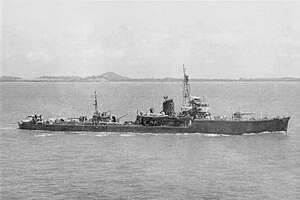No.7 (第七号掃海艇, Dai Nana Gō Sōkaitei), also sometimes called W-7 was a No.7-class minesweeper for the Imperial Japanese Navy. It was laid down on 27 October 1937, and completed on 16 June 1938.
 Minesweeper No. 7 near Singapore, September 23, 1942
| |
| History | |
|---|---|
| Name | W-7 |
| Builder | Mitsui Engineering & Shipbuilding |
| Laid down | 27 October 1937 |
| Launched | 16 June 1938 |
| Out of service | 10 June 1944 |
| Homeport | Sasebo, Nagasaki |
| Fate | Sunk at 11°34'N, 93°08'E. |
| General characteristics | |
| Class and type | W-7-class minesweeper |
| Displacement | 750 tons |
| Length | 72.2 m (236 ft 11 in) |
| Height | 7.9 m (25 ft 11 in) |
| Depth | 2 m (6 ft 7 in) |
| Installed power | 3,850 hp (2,870 kW) |
| Propulsion | Steam |
| Speed | 20 knots (37 km/h; 23 mph) |
| Range | 2,000 nmi (3,700 km; 2,300 mi) |
| Complement | 88 |
| Armament |
|
Background edit
W-7 was laid down on 27 October 1937. On 16 June 1938, the ship was launched, and numbered W-7. On 25 December, it was attached to the Sasebo Naval District. On 1 June 1941, it was assigned to MineSweepDiv 21 with W-8, W-9, W-10, W-11 and W-12.
The Philippines edit
On 27 November 1941, W-7 departed from Sasebo, and arrived at Peleliu on 4 December. On 8 December, it departed Peleliu and joined the Fourth Surprise Attack Unit. On 12 December, W-7 participated in the successful invasion of Legaspi. On 19 December 1941, after assisting briefly with operations in Borneo, came back to the Philippines to do some minesweeping. On the way to the Philippines, W-7 and W-8 helped escort a convoy to Lamon Bay, in the Philippines. The convoy arrived at Lamon Bay late at night, and conducted mine-sweeping operations. Two days later, W-7 and W-8 left Lamon Bay, and arrived at Davao on 31 December.
On 7 January, W-7 and MineSweepDiv 21's remaining ships, W-8, W-9, W-11 and W-12 (W-10 having been beached during actions off Vigan) departed from Davao and arrived at nearby Magunaga Bay.
Borneo edit
On 17 December, W-7, along with support from W-8, provided cover for the cruisers Kumano and Suzuya, light cruisers Yura and Kinu, seaplane tender Kamikawa Maru, destroyers Fubuki, Shirakumo, Murakumo, Shinonome, and Sagiri, the troop transport Hiyoshi Maru and a few subchasers during the invasion of Miri.
Dutch East Indies edit
On 9 January 1942, MineSweepDiv 21's remaining ships left Magunaga Bay, with the light cruiser Nagara, the submarine chasers CH-1, CH-2, and CH-3, and patrol boats P-1, P-2, and P-34. On 11 January, the convoy reached the city of Kema, and landed on Madano an hour later. On 20 January, MineSweepDiv 21 left Mandano, and on 21 January, conducted minesweeping operations around the area of Kendari. On 23–24 January, MineSweepDiv 21, along with other ships, helped escort the Kendari invasion force. On 29 January, W-7 helped escort the Ambon Seizure Convoy, and on 31 January, assists in the invasion. On 3 February, W-7 and W-8 left Ambon Island, heading back towards Staring Bay, in Kendari. It arrived there on 5 February. On 6 February, W-7 assisted in escorting the Makassar Occupation Force, and escorted the Kupang Seizure Convoy. On 14 February, W-7 and W-8 departed Makassar, and assisted in operations off Timor between 17 and 20 February. On 25 February, W-7 and W-8 departed from Kendari, and helped escort to Surabaya. After its operations in the Dutch East Indies, W-7 was assigned a series of escort and minesweeping jobs.[3]
Fate edit
After over two years of safe escorting and minesweeping operations (between 25 February 1942 and 15 April 1944), W-7 was spotted by the British submarine HMS Storm while escorting a merchant ship from Port Blair, Andaman Islands. Storm fired two torpedoes at the merchant ship, but both missed, and at least one hit W-7. After hitting W-7, Storm went after the merchant vessel. After some time, a submarine chaser and an aircraft arrived on the scene and picked up survivors from W-7. Almost an hour after being hit, W-7 "emitted a huge sheet of flames and slowly sank", according to HMS Storm's log. On 10 June W-7 was removed from the Navy's list.[4]
References edit
- ^ Budge, Kent G. "W-7 Class, Japanese Fast Minesweepers". The Pacific War Online Encyclopedia. Retrieved 22 April 2014.
- ^ "W-7 (+1944)". wrecksite.eu. Retrieved 22 April 2014.
- ^ a b Hackett, Bob; Cundall, Peter. "IJN Minesweeper W-7: Tabular Record of Movement". combinedfleet.com. Retrieved 22 April 2014.
- ^ "HMS Storm (P 233)". uboat.net. Retrieved 23 April 2014.